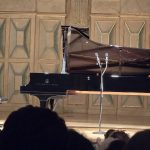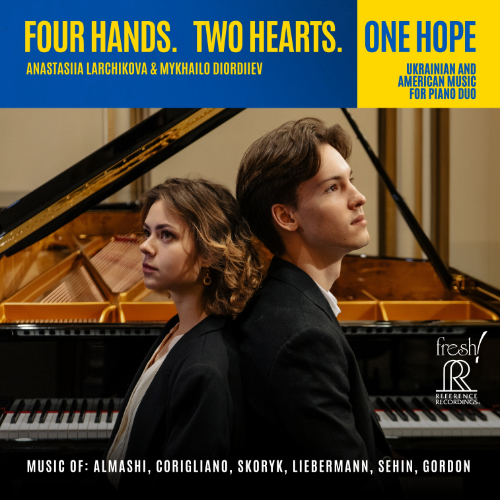Anastasiia Larchikova & Mykhailo Diordiiev, piano duo.
Zoltan AMASHI: Carpathian Song
John CORIGLIANO: Gazebo Dances
Myroslav SKORYK: Three Extravagant Dances
Lowell LIEBERMANN: Romance, Etude and Chorale, Op. 134
Bohdan SEHIN: Ru-um-bambar
Ricky Ian GORDON: Ring-A-Ding-Ding
Reference Recordings FR-762
Formats: CD, digital
Release Date: August 22, 2025
Total Duration: 59:10
Giorgio Koukl | 22 AUG 2025
Ukrainian piano duo Anastasiia Larchikova and Mykhailo Diordiiev are presenting their debut CD called Four Hands. Two Hearts. One Hope: Ukrainian and American Music for Piano Duo.
The composers chosen are an appealing mixture of known and entirely unknown names, a sign of interest, generally speaking. And in fact, the works are mostly interesting and fresh. So we can hear Almashi, Corigliano, Skoryk, Liebermann, Sehin, and Gordon. Without looking closely at the booklet, the listener will have difficulty distinguishing which scores are American and which are Ukrainian. This is certainly a very entertaining program, brilliantly played.
We can even enjoy three world premieres: the first one from Zoltan Amashi, a piece called Carpathian Song, which opens the CD. It is a very attractive music, perfectly integrated into the spirit of this West Ukrainian mountain scenery.
John Corigliano’s Gazebo Dances is a charming suite of four movements originally composed in 1972 for piano four-hands and later arranged by Corigliano himself for orchestra and concert band. The single movements are Overture, Waltz, Adagio, and an energetic Tarantella. Gazebo Dances is a delightful, accessible gem in Corigliano’s repertoire; effervescent, nostalgic, and adaptable across formats. Whether for performance or listening, it’s a joyful snapshot of summer charm and friendly musicality.
The pianists are perfectly integrated and very natural in any structure that has a certain speed; they struggle a little only when the music requires a more introspective approach. But when it comes to horrendously difficult technical acrobatics, they really seem to give their maximum. It is difficult to imagine a better rendering.
Myroslav Skoryk’s Three Extravagant Dances follows. This composer, who in his sad personal history followed so many of his compatriots’ destiny, being sent to Siberia by the Soviet regime as a child and then somehow managed to return, study music, and shortly before his death in 2020, obtained wide recognition at least in his native country. Sadly, he still awaits broader recognition worldwide, which certainly is overdue. The three parts are: “Entrance and Dance … almost Hispano-Moresque,” “Blues … almost American,” and “Can-can … as if from an old gramophone record.”
In this score, the two pianists truly find their top capacities to display. They are impeccably and ferociously immersed in the music, which seems written especially for them. They keep the listener dancing and never miss a single rhythmical detail. This is undoubtedly the best piece of the whole CD.
It is followed by another world premiere recording. Lowell Liebermann’s Romance, Etude and Chorale, Op. 134 is well-written, and Larichkova and Diordiiev certainly do their best to underline the score’s qualities. Despite this, there are far too many places which are not very inspiring.
Bohdan Sehin, with his Ru-um-bambar (1998/2023), is the third and last world premiere recording.
As a former pupil of Myroslav Skoryk, Mr. Sehin’s music is unsurprisingly clever, modern, and entertaining, a quality few contemporary composers can match.
Now this is another instance of the real challenge for pianists. Here, they underline the tiniest detail, never losing the overall picture in a really fabulous way, doing perfectly well, and hopefully introducing this music to the existing four-hand piano repertoire. One thing we have constantly kept in mind is that playing two pianos has its advantages, mostly in terms of space, while four hands means a constant danger of collisions and a very narrow space where every pianist can move. Well, never in all this program can one feel such a handicap.
The last piece on this CD is from Ricky Ian Gordon called Ring-A-Ding-Ding.
At two different places, somebody is required to shout this phrase while the pianist plays, a nice idea. In this case, it is the producer Mr. Kvitko who is in charge of this task. A pity that the level of the shout is a hint too low. Otherwise, the score is spectacular, certainly well chosen as the last piece, but lacks some originality.
Being the first CD of this piano duo, and with such an appealing repertoire, it is an easy recommendation. ■
EXTERNAL LINKS:
- Anastasiia Larchikova: facebook.com/anastasia.larchikova
- Mykhailo Diordiiev: facebook.com/mikhail.diordiev

Read more by Giorgio Koukl.
RECENT POSTS
 Jan Lisiecki transforms a marathon of preludes into a compelling narrative at Spivey Hall • 26 Nov 2025
Jan Lisiecki transforms a marathon of preludes into a compelling narrative at Spivey Hall • 26 Nov 2025 Dallas Symphony’s assistant conductor rises to the challenge in a program of premieres and familiar works • 25 Nov 2025
Dallas Symphony’s assistant conductor rises to the challenge in a program of premieres and familiar works • 25 Nov 2025





.png)